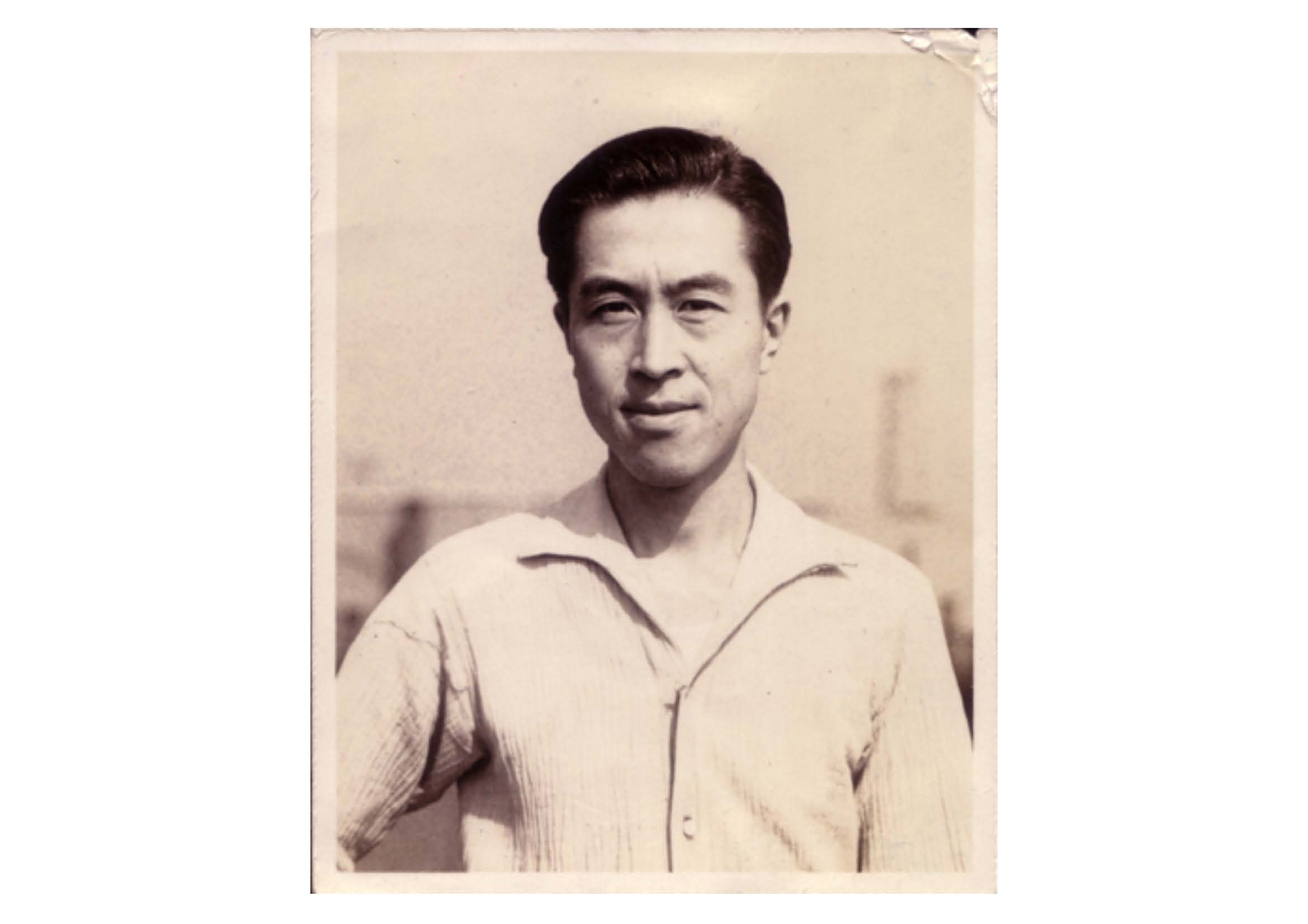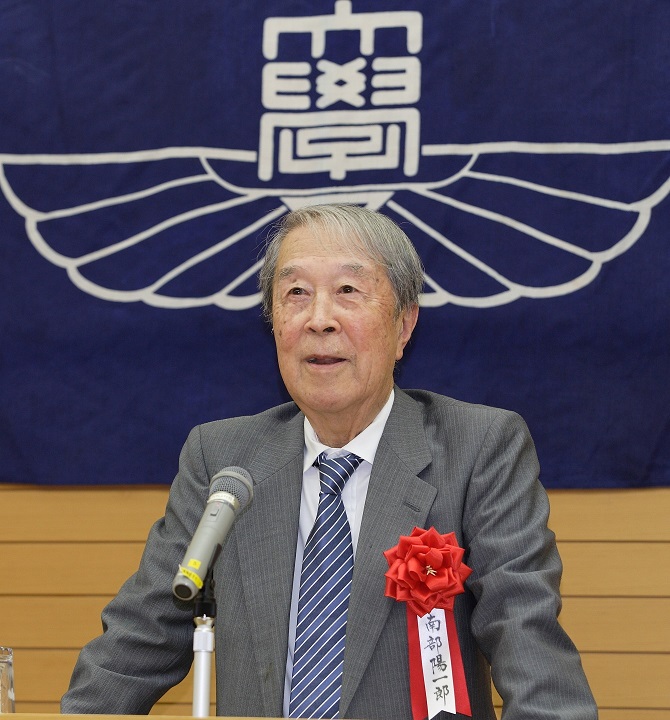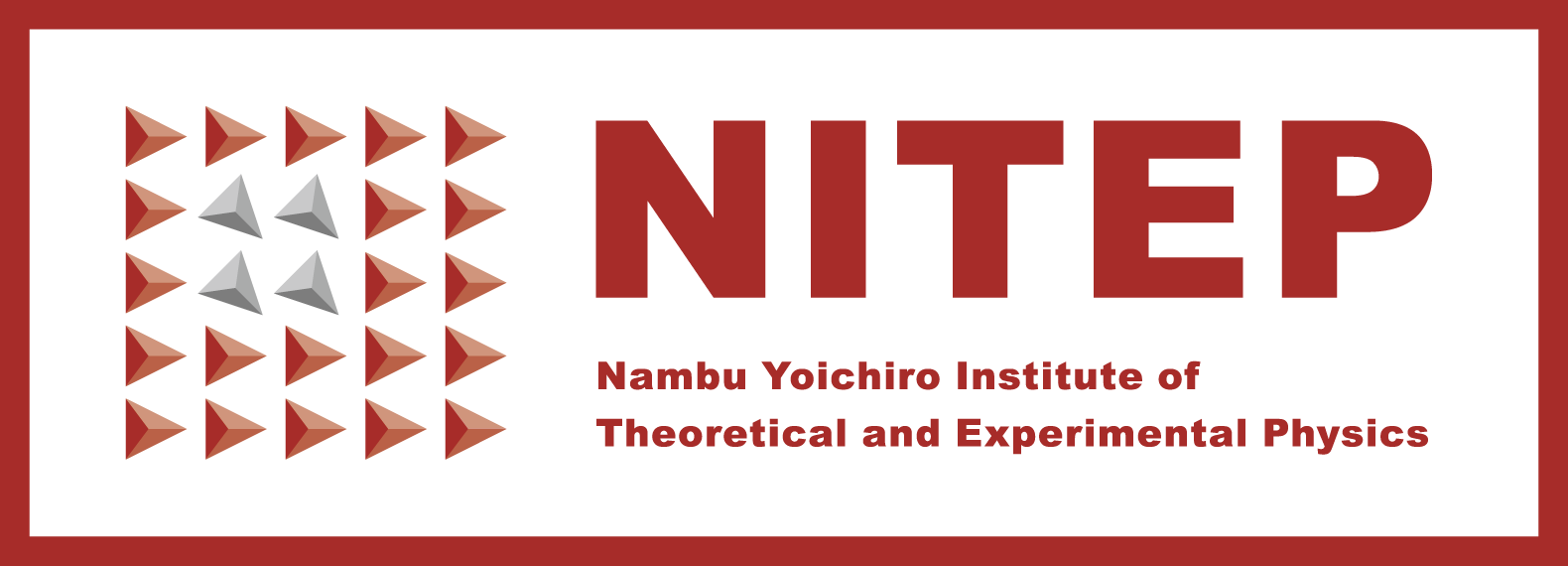About Prof. Youichiro Nambu
Yoichiro Nambu (1921-2015) and Osaka Metropolitan University

Yoichiro Nambu when he was posted to Osaka City University
After graduating from the Imperial University of Tokyo, he taught as a full-time professor at Osaka City University's Faculty of Science and Engineering (at that time), which was founded in 1949, and laid the foundation for basic scientific research at Osaka Metropolitan University today.

Yoichiro Nambu at the presentation ceremony of the Special Emeritus Professor at Osaka City University.
Special emeritus professor and professor emeritus at Osaka City University.
Papers written by Yoichiro Nambu during his time at Osaka City University (at that time)
- Yoichiro Nambu, Force Potentials in Quantum Field Theory, Progress of Theoretical Physics, Volume 5, Issue 4, Pages 614–633 (1950).
- Yoichiro Nambu, Yoshio Yamaguchi, Meson-Nucleon Scattering, Progress of Theoretical Physics, Volume 6, Issue 6, Pages 1000-1006 (1951).
- Yoichiro Nambu, On Lagrangian and Hamiltonian Formalism, Progress of Theoretical Physics, Volume 7, Issue 2, Pages 131–170 (1952).
- Yoichiro Nambu, The Relativistic Two-Body Problem, Soryushiron Kenkyu, Volume 1, Issue 3-1, pp. 133-141 (1949) [in Japanese].
- Toichiro Kinoshita, Yoichiro Nambu, On the Interaction of Mesons with the Electromagnetic Field (Continued), Soryushiron Kenkyu, Volume 1, Issue 3-2, pp. 176-181 (1949) [in Japanese].
- Yoichiro Nambu, On the Higher-Order Potential, Soryushiron Kenkyu, Volume 2, Issue 2, pp. 164-170 (1950) [in Japanese].
- Yoichiro Nambu, The Self-energy of the π-meson, Soryushiron Kenkyu, Volume 2, Issue 2, pp. 170-174 (1950) [in Japanese].
- Yoichiro Nambu, On the Higher-Order Potential (Errata), Soryushiron Kenkyu, Volume 2, Issue 4, pp. 172-173 (1950) [in Japanese].
- Yoichiro Nambu, The Relativistic Two-Body Problem, Soryushiron Kenkyu, Volume 2, Issue 5, pp. 57-62 (1950) [in Japanese].
- Yoichiro Nambu, On Extended Lagrangian and Hamiltonian Formalism. I, Soryushiron Kenkyu, Volume 3, Issue 3, pp. 1-40 (1951) [in Japanese].
- Yoshio Yamaguchi, Yoichiro Nambu, On the Scattering of the Meson with the Nucleon, Soryushiron Kenkyu, Volume 3, Issue 5, pp. 56-64 (1951) [in Japanese].
- Yoichiro Nambu, On Extended Lagrangian and Hamiltonian Formalism. II, Soryushiron Kenkyu, Volume 3, Issue 5, pp. 157-174 (1951) [in Japanese].
- Yoichiro Nambu, The W.K.B. Expansion of the S-matrix, Soryushiron Kenkyu, Volume 3, Issue 6, pp. 31-40 (1951) [in Japanese].
- Yoichiro Nambu, Dialogues Concerning New Particle Physics, Soryushiron Kenkyu, Volume 4, Issue 5, pp. 1-10 (1952) [in Japanese].
- Yoichiro Nambu, On the Scattering of the Mesons and the Nuclear Force, Soryushiron Kenkyu, Volume 4, Issue 5, pp. 17-33 (1952) [in Japanese].
- Yoichiro Nambu, A Story of the Elementary Particles, Soryushiron Kenkyu, Volume 7, Issue 2, pp. 77-83 (1952) [in Japanese].
Career, etc.
- 1942
- Received his Bachelor of Science from the Imperial University of Tokyo
- 1949
- Associate Professor at Osaka Metropolitan University(September~)
- 1950
- Professor at Osaka Metropolitan University (enrolled from March 1950 to August 1956)
- 1952
- Moved to the United States. A member of Institute for Advanced Study, Princeton
- 1956
- Associate Professor at University of Chicago
- 1958
- Professor at University of Chicago
- 1970
- Naturalized in the United States
- 1978
- Order of Culture
- 1978
- Professor Emeritus at Osaka Metropolitan University (November)
- 1991
- Professor Emeritus at the Fermi Laboratory, University of Chicago
- 2008
- The Nobel Prize in Physics
- 2011
- The Special Emeritus Professor at Osaka Metropolitan University(June)
- 2015
- Passed away(July)
Major awards
- 1970
- Dannie Heineman Prize for Mathematical Physics
("For his diverse and profound contributions to theory, specifically for analysis of symmetry breaking into particle physics and of gauge invariance in the BCS theory of superconductivity, as examples of mathematical physics.") - 1976
- J. Robert Oppenheimer Memorial Prize, the Center for Theoretical Studies, University of Miami
- 1978
- Order of Culture, Person of Cultural Merits, Government of Japan
- 1982
- The National Medal of Science (Physical Sciences), the President of the United States
("For seminal contributions to the understanding of elementary particles and their interactions.") - 1985
- Max Planck Medal, German Physical Society
- 1986
- The Dirac Medal of the ICTP, The International Centre for Theoretical Physics (ICTP), Trieste
("for being one of the first physicists to formulate the idea of spontaneous symmetry breaking and in particular, chiral symmetry breaking in relativistic particle physics. His contributions to the quark model in the 1960s and, later, his geometrical formulation of the dual resonance models as the dynamics of a relativistic string theory are of fundamental importance." ) - 1994
- J.J. Sakurai Prize for Theoretical Particle Physics, American Physical Society
( "For his many fundamental contributions to field theory and particle physics, including the understanding of the pion as the signaler of spontaneous breaking of chiral symmetry") - 1994/95
- The Wolf Prize in Physics, the Wolf Foundation in Israel
("for his contribution to elementary particle theory, including recognition of the role played by spontaneous symmetry breaking in analogy with superconductivity theory, and the discovery of the color symmetry of the strong interactions.") - 2005
- Benjamin Franklin Medal: Physics, The Franklin Institute
("For his path-breaking contributions leading to our modern understanding of sub-atomic particles--the Standard Model. His work has revolutionized our ideas about the nature of the most fundamental particles and the space through which they move.") - 2008
- The Nobel Prize in Physics
( "for the discovery of the mechanism of spontaneous broken symmetry in subatomic physics." )

 English
English
 日本語
日本語
